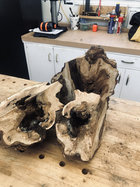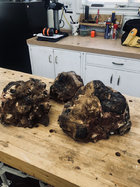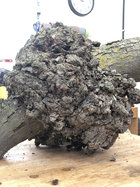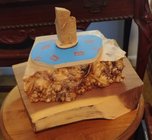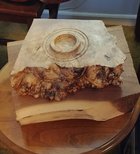-
It's time to cast your vote in the December 2025 Turning Challenge. (click here for details) -
Congratulations to Pat White for "Sicilian Mosaic" being selected as Turning of the Week for December 29, 2025 (click here for details) -
Welcome new registering member. Your username must be your real First and Last name (for example: John Doe). "Screen names" and "handles" are not allowed and your registration will be deleted if you don't use your real name. Also, do not use all caps nor all lower case.
You are using an out of date browser. It may not display this or other websites correctly.
You should upgrade or use an alternative browser.
You should upgrade or use an alternative browser.
Mounting Burl Orientation
- Thread starter James Lee
- Start date
What is your objective? Hollow form or bowl? The burl itself usually has very confused grain so- orientation is not as important. But if you are going to include the limb/trunk… the grain of it should be considered.
I was planning on a hollow form if possible. ThanksWhat is your objective? Hollow form or bowl? The burl itself usually has very confused grain so- orientation is not as important. But if you are going to include the limb/trunk… the grain of it should be considered.
I think I would try to mount it with the grain of the limb running parallel to the bed, if you can
Last edited:
Other things the HF turners on here might want to know in order to advise you:
Are you thinking you will make one piece out of this, or are you thinking of parting it out and making several?
What sort of wood is it?
What's the diameter of the non-burl part of things?
Are you thinking a natural edge hollow form with bark around the opening or getting rid of the bark?
Are you thinking you will make one piece out of this, or are you thinking of parting it out and making several?
What sort of wood is it?
What's the diameter of the non-burl part of things?
Are you thinking a natural edge hollow form with bark around the opening or getting rid of the bark?
Thanks Dean, I was thinking of making one large hollow form with a natural edge. The wood is maple. The non- burl part of the branch is 6" at one end and 4" at the other side. Is it okay to keep the pith if the burl is mounted using end grain with the limbs running parallel to the bed as suggested ?Other things the HF turners on here might want to know in order to advise you:
Are you thinking you will make one piece out of this, or are you thinking of parting it out and making several?
What sort of wood is it?
What's the diameter of the non-burl part of things?
Are you thinking a natural edge hollow form with bark around the opening or getting rid of the bark?
The pith will almost certainly crack. But the burl might be full of natural voids, bark inclusions, etc so a few extra cracks won't detract from the appearance. I would turn between centers in order to allow you to shift the piece around a little bit to optimize the form as the wood under the bark is revealed. I also would consider removing the bark before mounting, it is a pain to cut through and could fly off in big chunks. Mounting with the pith oriented in either direction could both be good. Depends on how big of an entry hole you want also. A "natural edge" may or may not include bark.
Thanks Michael. I removed the bark and was surprised how the size got reduced. Also there is a portion of the burl where the centre is already hollow. This might influence my plan. Perhaps, I might need to cut the burl into smaller pieces? Thanks againThe pith will almost certainly crack. But the burl might be full of natural voids, bark inclusions, etc so a few extra cracks won't detract from the appearance. I would turn between centers in order to allow you to shift the piece around a little bit to optimize the form as the wood under the bark is revealed. I also would consider removing the bark before mounting, it is a pain to cut through and could fly off in big chunks. Mounting with the pith oriented in either direction could both be good. Depends on how big of an entry hole you want also. A "natural edge" may or may not include bark.
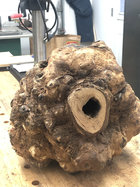
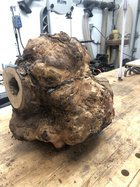
Last edited:
bottom pic looks like inclusion....be careful.....possible place to split
Looks like there is a natural place to cut it into two somewhat unequal halves.
Tom Gall
TOTW Team
Wow! Just noticed you have an uncluttered workbench. How do you do that? 
If must have hollow form u need to fit a plug to one end.....or turn he face grain....would have to be small and wood have 2 holes in side face grain.....end grain yellow glue to base might use dowel thru side/ plug with glue.....hollow will be safer than when shaping lower outside hf plus that inclusion needs duck tape on outside of hf...i like yellow glue over glue gun.....bowl safer than he with that inclusion
Hi Tom, pictures can be deceiving.Wow! Just noticed you have an uncluttered workbench. How do you do that?
Forgive my late arrival to the party but I “figured” I’d add my 2/100ths of a dollar. That hollow pith and reduced size wound lead me to make smaller burl pieces on the bandsaw for the always growing list of smaller spindle and facegrain projects I enjoy. Looks like great timber for boxes, lids, inlays, small tool and utensil handles and on and on. Great piece of wooden entropy.
@James Lee , I hope you'll post some follow up photos of how you end up cutting this burl apart and what you find inside.
I wanted to thank everyone for your help. I ended up cutting the burl into three pieces. I was a bit surprised to realize that there was quite a lot of deterioration around the core. Still, there are some good pieces to use. I think you guys might have saved me from disaster. Thanks for taking the time.